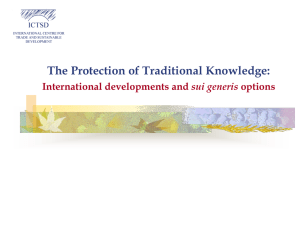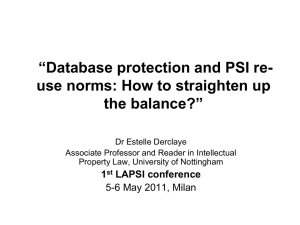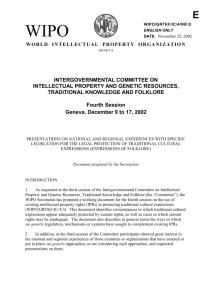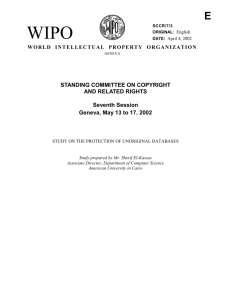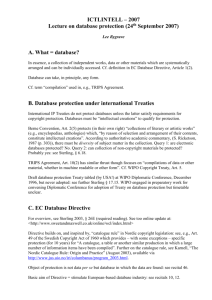Protection of Databases. Addendum to Document SCCR/1
advertisement
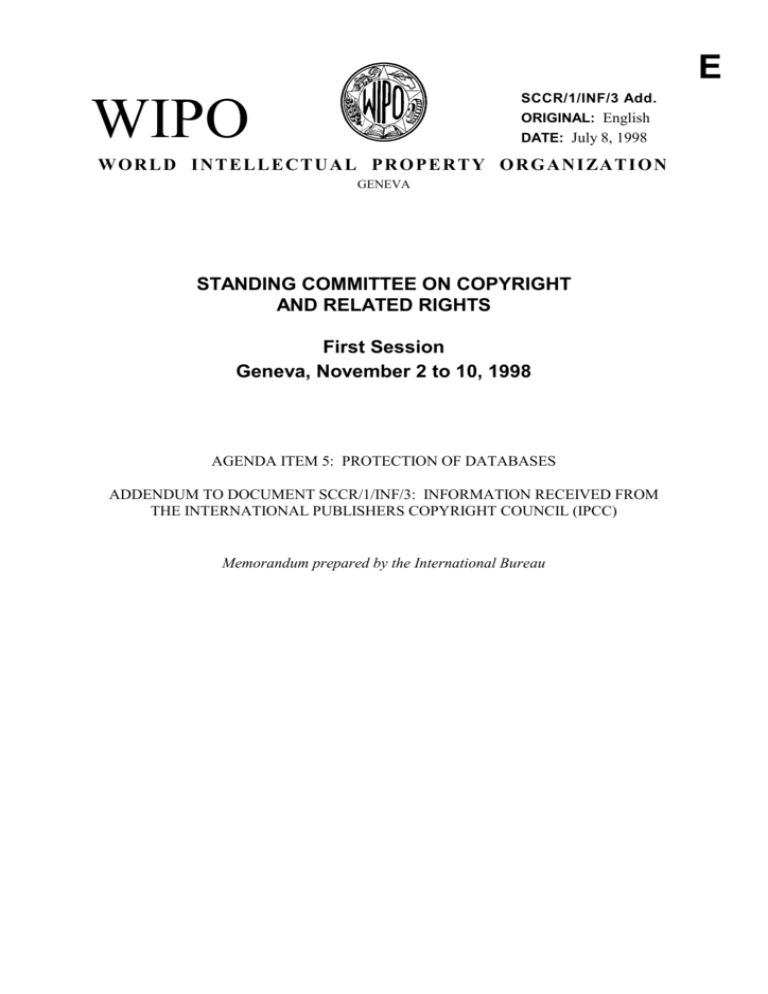
E SCCR/1/INF/3 Add. WIPO ORIGINAL: English DATE: July 8, 1998 W O R L D I N T E L L E C T U A L P R O P E R T Y O R G A N I ZA T I O N GENEVA STANDING COMMITTEE ON COPYRIGHT AND RELATED RIGHTS First Session Geneva, November 2 to 10, 1998 AGENDA ITEM 5: PROTECTION OF DATABASES ADDENDUM TO DOCUMENT SCCR/1/INF/3: INFORMATION RECEIVED FROM THE INTERNATIONAL PUBLISHERS COPYRIGHT COUNCIL (IPCC) Memorandum prepared by the International Bureau SSCR/1/INF/3 Add. page 2 1. The Annex to document SCCR/1/INF/3 contains information received from intergovermental and non-governmental organizations to the invitation mentioned in paragraph 1 of the document. 2. The International Bureau has also received information from the International Publishers’ Copyright Council (IPCC). This information is included in the Annex to the present document. [Annex follows] SCCR/1/INF/3 Add. ANNEX INFORMATION RECEIVED FROM THE INTERNATIONAL PUBLISHERS COPYRIGHT COUNCIL (IPCC) This memorandum by IPCC on behalf of IPA and STM responds to the main six headings [of the WIPO questionnaire on intellectual property in databases], and to the thrust of the individual questions raised. There is, however, considerable overlap in the individual questions (hardly surprising) and in the interests of clarity, this response is in narrative form. NEED FOR AND JUSTIFICATION OF A SUI GENERIS SYSTEM OF PROTECTION The potential of the Global Information Society depends on a WIPO International Treaty which will provide an “umbrella” for national Member States’ legislation for the protection of databases. Clearly, those legislations will need to be substantially equivalent, and in particular, and most importantly, there needs to be substantial equivalence between the EU sui generis right and the current formulations in the USA of a misappropriation approach as in the Collections of Information Antipiracy Act (HR 2652). The central justification for an international treaty on the sui generis system of protection for databases is that databases are central to establishing the Global Information Society. It may well be that a Global Entertainment Society can be established without sui generis protection for databases, but information databases lie at the heart of the entry of information of all kinds–scientific, technical, professional, financial, business, etc.–into the system of services which is sent round the world by the Internet. We approve and adopt the following extract from the intervention of Dr. Reinbothe, leading the Delegation of the Commission of the European Communities at the WIPO Information Meeting on Databases, on September 17 to 19, 1997: “Not only had new technological applications produced a revolution in the size and uses to which databases could be put, but those applications were at the very source of the Internet itself, which depended in large part on the databases which fed the system, just as it depended on the software and the communications technology which operated in the Internet and which operated related infrastructures in the information society. Therefore, databases played a central role. Their economic importance was steadily increasing. Third, and finally, just like any other electronic material, they were susceptible to being duplicated and transmitted anywhere in the world at the touch of a button. Databases were at the essence and the origin of the information society from which all wanted to benefit. They were particularly vulnerable. This raised the need to secure protection worldwide.” SSCR/1/INF/3 Add. Annex, page 2 POSSIBLE ALTERNATIVES FOR A SUI GENERIS SYSTEM The most common protection has in the common law countries lain in copyright. And, indeed, the dominant position of the UK database industry inside the EU has been due to the protection for investment provided by the low-level of originality required by UK case law known as “skill, judgment or labor.” That protection has become notably “thinner” through the adoption throughout the EU of the higher-level test of “the author’s own intellectual creation,” in the Database Directive. Both the uncertainty of this thin copyright protection and the virtual certainty that computer-assisted and indeed computer-generated databases will not pass the copyright test mean that an alternative form of protection is needed. The main interests which publishers have in copyright and neighboring rights are security of trading and authenticity. They will measure any initiative against the first yardstick–“will this initiative promote security of trading, so that we can invest with confidence that our products or services are not pirated with impunity?” Equally, publishers are deeply concerned with their own reputations. The American Medical Association has recently explained how much effort they put into validating the certification and licensing of information on physicians in their directory so that it can be relied upon by insurance companies and hospitals and other health care organizations. Database producers invest in quality products with careful validation and put their names on them as a level of insurance to the customer. The Feist decision which ended “sweat of the brow” protection in copyright in the USA in 1991 has introduced a long period of uncertainty and inconsistency which is exemplified in the decision of the Eleventh Circuit in Warren (1997) denying copyright protection to a uniquely defined selection of cable systems. In Canada a distinctly Gallic decision of the Federal Court of Appeals (“The use of the word copyright in the English version of the Act has obscured the fact that what the Act seeks to protect is “le droit d’auteur””) denied protection in copyright to a Yellow Page Directory (Tele-Direct v. American Business Information 1997). The conclusion must be not only that copyright is not an acceptable alternative system, but that its very failings in respect of compilations of data have led directly to the sui generis/misappropriation initiatives. The a priori economic right which the sui generis right represents was developed, interestingly, out of a first formulation which conceived the right as a special rule of unfair competition. That the right was, in years of intense debate in Europe, so developed indicates clearly that unfair competition is not a sufficient protection. In the words of a member of EU DG XV in an article on the common position reached by the EU Council of Ministers in 1995, the sui generis right is an economic right which “has nothing to do with unfair competition remedies because it does not sanction behavior a posteriori and because it provides for a term of protection.” Finally, the sui generis right is tradable [see EU Directive, Art. 7(3)]. Just as book publishers have elaborated licensing systems on the basis of the economic right of copyright, so database publishers and producers will be able to “slice and dice” information into new SSCR/1/INF/3 Add. Annex, page 3 packets of data and then elaborate systems of sale and/or license of them on the basis of the economic right of sui generis protection. NATURE AND EXTENT OF A POSSIBLE SUI GENERIS SYSTEM OF PROTECTION Discussion of the sui generis right is bedevilled by the ingrained habit of some commentators in importing into the debate concepts relevant to copyright. That habit is indeed reflected in the individual question “Is it justified to speak about intellectual property in cases where there is no intellectual creation but only investment?” The sui generis right is not an intellectual property right. It could be characterized as neighboring to a neighboring right, but it is not helpful and indeed confusing to view the object of protection, the scope of protection or the scope of limitations/exceptions through copyright spectacles. IPCC would support a broad “umbrella” approach by WIPO to defining the object of protection (there is already some equivalence between the EU Directive’s definition at Art. 1.2 and the definition at Sec. 1201 of HR 2652 in the USA), the minimal threshold of investment (not limited to deployment of financial resources, in the EU Directive, but including the expenditure of time, effort and energy), the acts protected against (extraction and re-utilization in the EU model) and limitations/exception (see also MAIN ELEMENTS below). THE IMPACT OF A POSSIBLE SUI GENERIS SYSTEM ON THE ACCESS TO DATABASES Given the security of trading offered to database publishers/producers by the sui generis right, an international treaty will promote very strongly the creation and licensing of information databases of all kinds. Providing protection will not restrict access–on the contrary it will enable, through licensing systems, more information to become available. The importance of licensing systems has been stressed in a recent paper from the Association of American Publishers (APP) entitled “Contractual Licensing, Technological Measures, and Copyright Law:” “Through contractual licensing, publishers are able to provide information or information access to specific classes of users, in ways that are carefully tailored to the specific nature of the product and needs of the users. This flexibility, in many instances, can have the effect of making information more widely available, or available to certain users at significantly lower cost. Examples are myriad. Publishers can adjust prices and other terms of availability to distinguish among commercial and non-profit users. Different packages of value-added features and minimum needs can be created and separately priced to accommodate larger and smaller users, corporations, educational institutions, and libraries. Since users pay for the type and amount of access and use they need, high-quality information products and services can be made available to users who could not otherwise SSCR/1/INF/3 Add. Annex, page 4 afford them. Thus, for example, as a single user paying a modest cost and agreeing to the terms of a standard for license agreement, and individual investor can be given access to the same information that is provided to a commercial investment firm under the terms of a negotiated but much more costly and complex license agreement.” The example, in the last sentence quoted above, of the single user with the form license getting the same high value information as the commercial investment firm underscores the point that providing protection does not restrict access but makes it more available to some who would not otherwise be able to afford it. The representatives of ICSU and of WMO expressed, on the contrary, at the WIPO Information Meeting of September 1997 their concerns that commercial database makers might “lock up” scientific information so that the free exchange of data in a cooperative not a competitive spirit which characterizes scientific advance could, to the enormous damage of that advance, be, contrary to the public interest, severely restricted. Again, IPCC responds to these concerns in the words of Dr. Reinbothe, leading the Delegation of the Commission of the European Communities in its intervention at the WIPO Information Meeting: “The Delegation stressed particularly three points. First, what was concerned was the private sector activity of the development and commercialization of databases for commercial exploitation. Where public interest requirements applied to provide for the public, and possibly free, availability of information from whatever sources, the rules which the European Community and its Member States proposed would not inhibit such use. As an example, where meteorological information was collected by certain means and the public interest and safety of human life, shipping and aviation security, etc., dictated the free exchange, processing and use of such information, in such a case, the proposal of the European Community and its Member States would in no way detract from those public interest goals and associated freedoms. However, that did not prevent a private operator from separately collecting, processing and marketing the same information, perhaps with additional information added, or special processing done to produce specific results for other purposes, for example, use by insurance companies for risk assessment purposes, in addition to the public interest tasks already mentioned. It was that latter activity, for example, risk assessment purposes and so on, which had an exclusively commercial context, which involved time and effort in its operation and which could only operate in a commercial market. Second, protection was only sought against the unauthorized extraction or re-use of all or a substantial part of the database, and none of the individual items of data, information or works, phonograms or fixed performances stored in a database could in themselves obtain protection under the European Community Directive or under the proposals the European Community had made in the WIPO context. Third, exceptions undoubtedly had to be provided in relation to teaching and scientific research, public security or judicial and government purposes.” SSCR/1/INF/3 Add. Annex, page 5 It is important to distinguish between protection of investment in the compilation of “public” information and the general availability of that information. Sec. 1203(b) of HR 2652 states what should be obvious: “Nothing in this chapter shall restrict any person from independently gathering information or using information obtained by means other than extracting it from a collection of information gathered, organized or maintained by another person through the investment of substantial monetary or other resources.” MAIN ELEMENTS OF A PROTECTION SYSTEM Subject matter and criteria of protection See in general under NATURE AND EXTENT above. Here, again, the tendency to view the sui generis right through copyright spectacles is seen in e.g. the question “Should such a definition [of database] and thus the sui generis protection extend to both original and non-original databases?” A sui generis right has nothing to do with originality: it is to do, quite explicitly, with investment. It will be neither possible nor helpful to attempt, at international treaty level, to pin down in statutory language the meaning of qualifying language such as “substantial” in relation to investment, or “insubstantial” in relation to extraction. In the long term judicial interpretation is a safer procedure. Thus, in the UK, the Copyright Acts contain no definitions of either originality or substantiality, but cases decided over time have given considerable security of meaning to interested parties. Admittedly “over time” can mean a considerable number of years or even decades, but the procedure is, on balance, preferable to what may be very damaging over-restrictive language in a digital world we are only just entering. Right holders The “maker of the database” as the right holder can, perhaps, only be defined by the criteria for investment which define the making. Art. 7.1 of the EU Directive requires a substantial investment “in either the obtaining, verification or presentation of the contents” of the database. If a publisher/producer cannot demonstrate a substantiality of investment in these three activities, then he is not a sufficient “maker” for the purposes of the Directive. Rights to be granted As to the definition of substantial/insubstantial see MAIN ELEMENTS above. In the EU Directive the right of the maker is set out at Art. 7.1 as the right “to prevent extraction and or re-utilization of the whole or of a substantial part, evaluated qualitatively and/or quantitatively, of the contents of that database.” Art. 7.2 then defines “extraction” (Art. 7.2(a)) and “re-utilization” (Art. 7.2(b)) in terms so familiar as not requiring repetition here. The provision of Sec. 1202 headed “Prohibition SSCR/1/INF/3 Add. Annex, page 6 against Misappropriation” of HR 2652 is, perhaps, not so familiar and is, therefore, worth repeating here in its present version: “Any person who extracts, or uses in commerce, all or a substantial part, measured either quantitatively or qualitatively, of a collection of information gathered, organized, or maintained by another person through the investment of substantial monetary or other resources, so as to cause harm to the actual or potential market of that other person, or a successor in interest of that other person, for a product or service that incorporates that collection of information and is offered or intended to be offered for sale or otherwise in commerce by that other person, or a successor in interest of that person, shall be liable to that person or successor in interest for the remedies set forth in section 1206.” One interesting feature of the approach of HR 2652 is the explicit marking out of protection as relating to commercial misappropriation, due to the grounding of the statute in the Commerce Clause of the Constitution. However, the Committee Report on the bill notes that unauthorized extraction from a database even for non-commercial purposes could fall within the prohibition of the bill. “... the act of extraction itself could fall within the prohibition of the bill even if it is non-commercial and private, in order to safeguard against the destruction of a market from the members of the intended market simply downloading a collection for their own use without authorization or payment.” There are important safeguards in HR 2652, e.g. for extracting or use of information for non-profit educational, scientific, or research purposes in a manner that does not harm the actual or potential market for the product or service [Sec. 1203 (d)]. Government data is expressly excluded from protection at Sec. 1204. Further, Sec. 1203(c) allows “any person” to make use of a database to verify the accuracy of information gathered, organized, or maintained by that person. To the specific question “Is it not sufficient to grant a right of reproduction?” the answer must be that it is not, given the failure of the WIPO Copyright Treaty to grapple with this issue beyond the very general language of Berne, Art. 9(1). Exceptions To answer the specific last question first “Should there be specific exceptions for developing countries?”–the answer is NO. One of the most exciting features of new technology is that it may allow developing countries to by-pass some present analogue channels of communication and enter at once into the digital channel. Some developing countries, e.g. India, have very expert computer-related skills, and it is not difficult to forecast for the new future investment by industries in such countries in database creation and communication. It will be no service to such industries to have their own national laws riddled by internationally approved exceptions to rights. In general, the issue of exceptions does need revisiting. Art. 9 of the EU Directive combines a narrow view with some uncertainties of meaning (e.g. what are “the purposes of SSCR/1/INF/3 Add. Annex, page 7 illustration” in Art. 9(b)?). As Professor Bernt Hugenholtz has suggested–“Apparently, the users’ freedom to extract or re-utilize insubstantial parts of the database was considered, by the European legislation, to be sufficient.” It may, indeed, be possible that “umbrella” WIPO Treaty language on exceptions might require the EU itself to revisit the Directive, possibly as part of the examination of the sui generis right built into the Directive at Art. 16.3. Duration of protection The EU Directive started with the Scandinavian “catalogue right” period of 10 years, and ended with 15 years renewable. The terms for renewal for the EU rights are sufficiently familiar not to need repeating here. IPCC has no quarrel with those terms. Under the US initiative at HR 2652 protection for a period of 15 years is provided from the time of the investment. National treatment It effect, through adherence in equivalent terms to a WIPO Treaty. Application in time Shortly, YES, especially in view of databases created under national implementations of the EU Directive. EXERCISE AND INFRINGEMENT OF RIGHTS The sui generis right will become the economic basis of licensing of databases as services on-line, and sale or licensing/rental of databases off-line. Both criminal and civil law sanctions should be available against infringement. HR 2652 has at Secs. 1206 & 1207 some interesting limitations on both civil and criminal remedies. The only realistic answer to the question “How may infringements be identified?” is, as with copyright infringements, “with difficulty”! However the work on unique identifiers e.g. the Digital Object Identifier (DOI) and Electronic Copyright Management Systems (ECMS) currently being intensively developed may provide means of identifying unauthorized uses. [End of Annex and of document]
